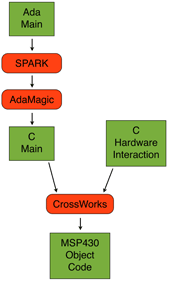Software Components
Most of the software we write that flies in space is written in SPARK, a subset of the
Ada programming language that supports program
verification. With the use of appropriate tools, SPARK programs can be mathematically
proved free of runtime error, and they can have other correctness properties proved as
well.
Basic Low Earth Orbit
Our basic low-earth orbit CubeSat uses the SPARK 2005 language. As far as we are aware
our CubeSat is the first spacecraft of any kind to use SPARK (although other spacecraft
have used Ada). We should note, however, that some of the low-level drivers and a third
party library for manipulating our SD card are written in C. We hope to minimize the
amount of C in future missions.
Our software makes no use of an operating system but instead runs on the bare metal. The
SPARK code was compiled with all checks suppressed, which we felt was justified by using
the SPARK tools to prove the program free of runtime error (see below for more
information). This also allowed us to eliminate the Ada runtime system from the
executable, saving space and further reducing the amount of unproved code used.

We used the Texas
Instruments MSP430 microcontroller due to its exceptionally low power
consumption and our prior experience with it in the Alaskan
Ice Buoy project. Unfortunately, when we started our project, there was no Ada
compiler available for the MSP430. Thus, we used a tool chain, shown at right, that
converted the SPARK to C using SofCheck's
AdaMagic compiler. We then compiled the C, along with the required low-level drivers and
libraries, to MSP430 object code using Rowley
Associates' CrossWorks.
The primary Ada development was done using the GPS integrated development environment
from AdaCore. GPS supports integration with
SPARK and the GNAT Ada compiler was used for compiling and running tests. AdaMagic was
only used to generate the final flight software via CrossWorks as described above.
Software Metrics
The SPARK portion of the flight control program consists of 5991 lines of code and 4095
lines of comments (where 2843 comment lines are actually SPARK annotations), for a total
of 10,086 lines. These numbers do not consider blank lines. The SPARK 2005
Examiner found the code base free of flow errors but issued 72 warnings, mostly related to
automatically generated loop assertions. The Examiner generated 4542 verification
conditions (VCs) of which all but 102 were proved automatically. Thus, 98% of all VCs were
proved. In this project we attempted to prove the program free of runtime errors (to
support our decision to suppress all checks), but we did not specifically attempt to prove
any higher level properties of the program. Also, due to lack of time before launch, we
did not pursue the remaining 102 unproved VCs either formally, for example, with the
checker tool, or via focused testing.
The C portion of the flight control program consists of 2239 lines (including
blank lines). This does not include the header files or source files of the third party SD
card library. Thus, the C portion of the flight control program is approximately 18% of
the total. However, that number is somewhat inflated because the count of C source lines
above includes blank lines.
The final executable consumes 3874 bytes of RAM (not including stack space) and 45,428
bytes of ROM. On our processor this corresponds to 47% of the RAM and 38% of the ROM.
These numbers include the space consumed by the third party SD card library we used. No
attempt was made, however, to analyze stack space consumption.
